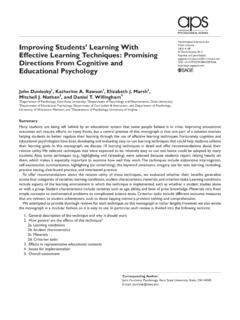Transcription of Learners’ Listening Comprehension Difficulties in English ...
1 English Language Teaching; Vol. 9, No. 6; 2016 ISSN 1916-4742 E-ISSN 1916-4750 Published by Canadian Center of Science and Education 123 Learners Listening Comprehension Difficulties in English Language Learning: A Literature Review Abbas Pourhosein Gilakjani1 & Narjes Banou Sabouri2 1 Lahijan Branch, Islamic Azad University, Lahijan, Iran 2 Department of Linguistics, Payame Noor University, Tehran, Iran Correspondence: Abbas Pourhosein Lahijan Branch, Islamic Azad University, Lahijan, Iran. Tel: 98-142-623-2762. E-mail: Received: April 6, 2016 Accepted: May 5, 2016 Online Published: May 6, 2016 doi: URL: Abstract Listening is one of the most important skills in English language learning. When students listen to English language, they face a lot of Listening Difficulties .
2 Students have critical Difficulties in Listening Comprehension because universities and schools pay more attention to writing, reading, and vocabulary. Listening is not an important part of many course books and most teachers do not pay attention to this important skill in their classes. In this paper, the researchers reviewed the terms Listening , Listening Comprehension , Listening Comprehension strategies, and Listening Difficulties . The review of literature indicated that when teachers are aware of students learning Difficulties they can help them develop effective Listening strategies and finally solve their Difficulties in Listening and improve their Listening Comprehension abilities. Keywords: Listening , Listening Comprehension , strategies, Difficulties 1. Introduction There are a lot of definitions of the term Listening .
3 Chastain (1971) stated that the goal of Listening Comprehension is to comprehend the language at normal speed in an automatic condition. Hamouda (2013) said that Listening skill is very important in acquiring understandable input. Learning does not occur if there will not be any input. Pourhosein Gilakjani and Mohammadreza Ahmadi (2011) expressed that Listening has an important role in the communication process. According to Pourhosein Gilakjani and Seyedeh Masoumeh Ahmadi (2011), out the four main areas of communication skills called Listening , speaking, reading, and writing, Listening is the most important of all. Goss (1982) said that in Listening Comprehension listeners try to construct a meaning when they get the information from the Listening source. Steinberg (2007) and Azmi Bingol, Celik, Yidliz, and Tugrul Mart (2014) defined Listening Comprehension as one s ability to recognize another through sense, aural organs and allocate a meaning to the message to understand it.
4 According to Richards, John Platt, and Heidi Platt (2000) and Pourhosein Gilakjani and Seyedeh Masoumeh Ahmadi (2011), Listening Comprehension is the process of understanding speech and it concentrates on role of linguistic units such as phonemes, words, and grammatical structures and the role of listener s anticipations, the situation and context, previous knowledge, and the subject. Osada (2004) expressed that Listening skill didn t receive sufficient acceptance in its own right but rather has been considered as a passive skill that will develop without help. According to Morley (2001) and Rost (2001), Listening is the most important skill for language learning because it can be mostly used in normal daily life and develops faster than the other language skills which indicates that it makes easy the development of the other language skills.
5 According to Hamouda (2013), EFL learners have crucial problems in Listening Comprehension because universities pay attention to grammar, reading, and vocabulary. Listening and speaking skills are not significant parts of many books and teachers do not consider these skills in their classes. Osada (2004) stated that Listening is not very important for both teachers and learners and teachers test not to teach Listening and learners learn Listening not Listening Comprehension . Consequently, it remains the most neglected aspect of language teaching. Hamouda (2013) emphasized that comprehending speech is a very difficult activity for students. Learners face a lot of problems when they listen to a language. If teachers are expected to assist learners to improve their Listening Comprehension , they should comprehend their Listening Difficulties in understanding spoken passages English Language Teaching Vol.
6 9, No. 6; 2016 124 and teach them effective Listening Comprehension strategies to be able to solve their Listening Comprehension problems. In this review paper, the researchers reviewed the strategies of Listening Comprehension and then identified the learners Listening Comprehension problems when Listening to oral texts. This paper intended to increase teachers consciousness of these difficult areas in Listening Comprehension so that suitable and effective actions can be adopted. It is hoped that the findings of this review paper provide good views for the teaching and learning of Listening Comprehension for both teachers and learners. 2. Definition of Listening Listening has been defined by many researchers. Chastain (1971) defined Listening as the ability to understand native speech at normal speed.
7 Morley (1972) said Listening involves auditory discrimination, aural grammar, selecting necessary information, remembering it, and connecting it to the process between sound and form of meaning. According to Postovsky (1975), Listening differs in meaning from sound discrimination to aural Comprehension . Goss (1982) defined Listening as a process of understanding what is heard and organizing it into lexical elements to which meaning can be allocated. Bowen, Madsen, and Hilferty (1985) demonstrated that Listening is understanding the oral language. Students hear oral speech, divide sounds, classify them into lexical and syntactic units, and comprehend the message. Listening is a process of receiving what the speaker says, making and showing meaning, negotiating meaning with the speaker and answering, and creating meaning by participation, creativity, and empathy.
8 According to Purdy (1997), Listening is the process of receiving, making meaning from, and answering to spoken and/or nonverbal messages. Rost (2002) defined Listening as a complex process of interpretation in which listeners match what they hear with what they already know. According to Rost (2009), Listening helps us to understand the world around us and is one of the necessary elements in creating successful communication. Jafari and Hashim (2015) emphasized that Listening is a channel for comprehensible input and more than 50 percent of the time learners spend in learning a foreign language is devoted to Listening . 3. Definition of Listening Comprehension The term Listening Comprehension has been defined by different authors. According to Brown and Yule (1983), Listening Comprehension means that a person understands what he/she has heard.
9 If he/she learns the text through hearing it, he/she will understand it. Dirven and Oakeshott-Taylor (1984) defined Listening Comprehension as the product of teaching methodology and is matched by terms such as speech understanding, spoken language understanding, speech recognition, and speech perception. Rost (2002) and Hamouda (2013) defined Listening Comprehension as an interactive process in which listeners are involved in constructing meaning. Listeners comprehend the oral input through sound discrimination, previous knowledge, grammatical structures, stress and intonation, and the other linguistic or non-linguistic clues. According to Nadig (2013), Listening Comprehension is the various processes of understanding and making sense of spoken language. These involve knowing speech sounds, comprehending the meaning of individual words, and understanding the syntax of sentences.
10 4. Listening Comprehension Strategies Goh (2000) said that it is very important to teach Listening strategies to students and before doing this, teachers should increase learners knowledge of vocabulary, grammar, and phonology. According to Vandergrift (1999), the development of strategy is significant for the training of Listening and learners can guide and assess their own understanding and answers. Many researchers such as Conrad (1985), O Mallay and Chamot (1990), and Rost and Ross (1991) and Azmi Bingol, Celik, Yidliz, and Tugrul Mart (2014) expressed that there are three types of strategies in Listening Comprehension . They are cognitive, metacognitive, and socio-affective. These strategies can change based on the level of learners. Cognitive Strategies Cognitive strategies are related to understanding and gathering input in short term memory or long-term memory for later use.














